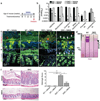Core 1- and 3-derived O-glycans collectively maintain the colonic mucus barrier and protect against spontaneous colitis in mice
- PMID: 27143302
- PMCID: PMC5097036
- DOI: 10.1038/mi.2016.45
Core 1- and 3-derived O-glycans collectively maintain the colonic mucus barrier and protect against spontaneous colitis in mice
Abstract
Core 1- and 3-derived mucin-type O-glycans are primary components of the mucus layer in the colon. Reduced mucus thickness and impaired O-glycosylation are observed in human ulcerative colitis. However, how both types of O-glycans maintain mucus barrier function in the colon is unclear. We found that C1galt1 expression, which synthesizes core 1 O-glycans, was detected throughout the colon, whereas C3GnT, which controls core 3 O-glycan formation, was most highly expressed in the proximal colon. Consistent with this, mice lacking intestinal core 1-derived O-glycans (IEC C1galt1-/-) developed spontaneous colitis primarily in the distal colon, whereas mice lacking both intestinal core 1- and 3-derived O-glycans (DKO) developed spontaneous colitis in both the distal and proximal colon. DKO mice showed an early onset and more severe colitis than IEC C1galt1-/- mice. Antibiotic treatment restored the mucus layer and attenuated colitis in DKO mice. Mucins from DKO mice were more susceptible to proteolysis than wild-type mucins. This study indicates that core 1- and 3-derived O-glycans collectively contribute to the mucus barrier by protecting it from bacterial protease degradation and suggests new therapeutic targets to promote mucus barrier function in colitis patients.
Conflict of interest statement
The authors declared no conflict of interest.
Figures






References
Publication types
MeSH terms
Substances
Grants and funding
LinkOut - more resources
Full Text Sources
Other Literature Sources
Medical
Molecular Biology Databases

